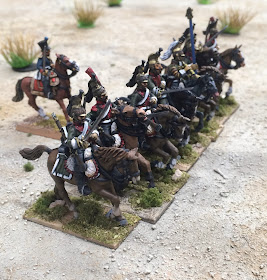We are currently working on a small
campaign based on the retreat to Corunna by Moore forces for Sharp Practice. The campaign rules
are not ready yet and Richard Clarke already warned that we should dump away
the Chain of Command mentality, as in this period battles are less important
than outmanoeuvring your foes in the field. For this reason, the plan is to
play four interlinked scenarios instead of a full campaign with the same
forces. Eventually (...this is our intention..) the campaign will be published in the
Summer Special 2016.
The game today was the action taking
place on 3 January 1809, a rearguard defensive battle of the British at the
town of Cacabelos in El Bierzo (Leon) area. It is a well known action because the
French commander General Colbert was killed by a British rifle marksman called
Thomas Plunkett killed at an uncertain distance. There is some confusion about this
event, but likely a known impatient Colbert risked too much when reconnoitring
the advanced outpost and rifleman Plunkett took his chances... and hit bang on
target.
 |
| Dashing French Dragoons |






